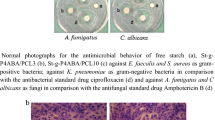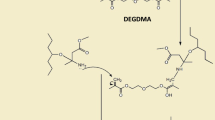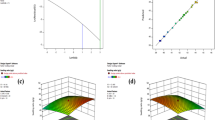Abstract
The starch was blended with poly(vinyl) alcohol (PVA) to develop PVA/starch (PS) hydrogel. The physical interaction of PVA with starch was concluded by FTIR and XRD techniques. The thermal decomposition behavior of PS hydrogel was analyzed by thermogravimetric analysis. The swelling index and moisture loss analysis was carried out to comprehend the water absorption and retention behavior of PS hydrogel. The PS hydrogel was biocompatible with RBC due to its lower hemolysis value. The curcumin-loaded PS hydrogel showed an excellent anticancer activity against breast cancer cell line. The antibacterial activity of cephalosporin-loaded PS hydrogel was evaluated against the Staphylococcus aureus.

Graphical abstract
Highlights
-
The PVA/mannitol hydrogel was prepared to study its drug delivery potential.
-
The PM hydrogel effectively delivered the drugs against MCF-7 and pathogenic strains.
-
The PM hydrogel exhibited an excellent water retention ability.
-
The prepared PM hydrogel was non-hemolytic to red blood cells.








Similar content being viewed by others
References
Caló E, Khutoryanskiy VV (2015) Biomedical applications of hydrogels: a review of patents and commercial products. Eur Polym J 65:252–267. https://doi.org/10.1016/j.eurpolymj.2014.11.024
Kurhade S, Momin M, Khanekar P, Mhatre (2013) Novel biocompatible honey hydrogel wound healing sponge for chronic ulcers. Int J Drug Deliv 5:353–361
Silva AKA, Richard C, Bessodes M, Scherman D, Merten OW (2009) Growth factor delivery approaches in hydrogels. Biomacromolecules Biomacromol 10(1):9–18. https://doi.org/10.1021/Bm801103c
Chen DH, Leu JC, Huang TC (1994) Transport and hydrolysis of urea in a reactor–separator combining an anion exchange membrane and immobilized urease. J Chem Technol Biotechnol 61:351–357
Hyon SH, ChaWI, Ikada Y, KitaM, Ogura Y, Honda Y (1994) Poly (vinyl alcohol) hydrogels as soft contact lens material. J Biomater Sci Polym Ed 5:397–406. https://doi.org/10.1163/156856294x00103
Shan J, Liu S, Wenhao F (2011) PVA hydrogels properties for biomedical application. J Mech Behav Biomed Mater J Mech Behav Biomed Mat 4(7):1228–1233. https://doi.org/10.1016/j.jmbbm.2011.04.005
Yi H, Chen C, Kemin L, Ying T, Zhang L, Yubao L (2015) Preparation of PVA hydrogel with high transparency and investigations of its transparent mechanism. RSC Adv 31(5):24023–24030. https://doi.org/10.1039/C5RA01280E
Peng L, Zhou Y, Lu W et al. (2019) Characterization of a novel polyvinyl alcohol/chitosan porous hydrogel combined with bone marrow mesenchymal stem cells and its application in articular cartilage repair. BMC Musculoskelet Disord 20:257. https://doi.org/10.1186/s12891-019-2644-7
Anuj K, Sung SH (2016) PVA-based hydrogels for tissue engineering: a review. Int J Polym Mater Polym Biomater Int J Polym Mat Polym Biomat 66(4):159–182. https://doi.org/10.1080/00914037.2016.1190930
Elbadawy AK, El-Refaie SK, Xin C (2017) A review on polymeric hydrogel membranes for wound dressing applications: PVA-based hydrogel dressing. J Adv Res 8(3):217–233. https://doi.org/10.1016/j.jare.2017.01.005
Shitole AA, Raut PW, Khandwekar A et al. (2019) Design and engineering of polyvinyl alcohol based biomimetic hydrogels for wound healing and repair. J Polym Res 26:201. https://doi.org/10.1007/s10965-019-1874-6
Bahadoran M, Shamloo A, Nokoorani YD (2020) Development of a polyvinyl alcohol/sodium alginate hydrogel-based scaffold incorporating bFGF-encapsulated microspheres for accelerated wound healing. Sci Rep. 10:7342. https://doi.org/10.1038/s41598-020-64480-9
Liu C, Gan X, Chen Y (2010) A novel pH‐sensitive hydrogels for potential colon‐specific drug delivery: Characterization and in-vitro release studies. Starch Stark 63(8):503–511. https://doi.org/10.1002/star.201000120
Kunal P, Ajith B, Dipak KM (2006) Preparation of transparent starch based hydrogel membrane wit potential application as wound dressing. Trend Biomat Artif Organ 20(1):59–57
Vijaya SW, Pallavi RW, Sathish D, Aparna D, Ratnesh J, Prajakta D (2018) Starch based nanofibrous scaffolds for wound dressing applications Bioact Mater Bioact Mater 3(3):255–266. https://doi.org/10.1016/j.bioactmat.2017.11.006
Awais H, Niazi MBK, Arshad H, Sarah F, Tahir A (2018) Development of anti-bacterial PVA/starch based hydrogel membrane for wound dressing. J Polym Environ 26:235–243. https://doi.org/10.1007/s10924-017-0944-2
Hwang M-R, Kim JO, Lee JH et al. (2010) Gentamicin-loaded wound dressing with polyvinyl alcohol/dextran hydrogel: gel characterization and in vivo healing evaluation. AAPS PharmSciTech 11:1092–1103. https://doi.org/10.1208/s12249-010-9474-0
Yang JM, Su WY, Leu TL, Yang MC (2004) Evaluation of chitosan/ PVA blended hydrogel membranes. J Membr Sci 236:39–51. https://doi.org/10.1016/j.memsci.2004.02.005
Dominique LW, Isabel S, Giovanna F (2020) Starch-based hydrogels produced by high-pressure processing (HPP): effect of the Starch Source and Processing Time. Food Eng Review https://doi.org/10.1007/s12393-020-09264-7
Tianxue Z, Jiajun M, Yan C, Haoran L, Lu L, Mingzheng G, Shuhui L, Jianying H, Zhong C, Huaqiong L, Lei Y, Yuekun L (2019) Recent progress of polysaccharide‐based hydrogel interfaces for wound healing and tissue engineering. Advan Mat Inter 6(17):e1900761. https://doi.org/10.1002/admi.201900761
Selvi J, Parthasarathy V, Mahalakshmi S, Anbarasan R, Kumar PS, Daramola MO (2019) Enhancement in thermal, mechanical and electrical properties of novel PVA nanocomposite embedded with SrO nanofillers and the analysis of its thermal degradation behavior by nonisothermal approach. Poly Compos 1–14. https://doi.org/10.1002/pc.25453
Huafeng T, Jiaan Y, Varada R, Aimin X, Xiaogang L (2017) Fabrication and properties of polyvinyl alcohol/starch blend films: effect of composition and humidity. Int J Biol Macromol 96:518–523. https://doi.org/10.1016/j.ijbiomac.2016.12.067
Jeiffer FV, José GE, Vidala MV, Jorgelina P, Pedro MC, Henry ALM (2018) Chemical Modification and Characterization of Starch Derived from Plantain (Musa paradisiaca) Peel Waste, as a Source of Biodegradable Material, Chemical Engineering Transactions. Chem Eng Transact 65 https://doi.org/10.3303/CET1865128
Selvi J, Parthasarathy V, Mahalakshmi S, Anbarasan R, Daramola MO, Senthil KP (2020) Optical, electrical, mechanical, and thermal properties and non-isothermal decomposition behavior of poly(vinyl alcohol)—ZnO nanocomposites. Iran Polym J 29:411–422. https://doi.org/10.1007/s13726-020-00806-8
Ng KW, Achuth HN, Moochhala S, Lim TC, Hutmacher DW (2007) In vivo evaluation of an ultra-thin polycaprolactone film as a wound dressing J Biomat Sci Polym Ed 18(7):925–938. https://doi.org/10.1163/156856207781367693
Bárbara B, Wyller MF, Rosana C, Shanise L, Loong-Tak L, Álvaro RG, Elessandra Z (2018) Starch hydrogels: the influence of the amylose content and gelatinization method. Intern J Biol Macromol 113:443–449. https://doi.org/10.1016/j.ijbiomac.2018.02.144
Todor TK, Juan CMG, DinuIuga YZ, Khimyak FJW (2020) Structural heterogeneities in starch hydrogels. Carb Polym 249:116834. https://doi.org/10.1016/j.carbpol.2020.116834
Tavakoli J, Mirzaei S, Tang Y (2018) Cost-effective double-layer hydrogel composites for wound dressing applications. Polymer 10(3):305. https://doi.org/10.3390/polym10030305
Kerong Y, Qing H, Bingpeng C, Yuhao Z, Kesong Z, Qiang L, Jincheng W (2017) Antimicrobial hydrogels: promising materials for medical application. Int J Nanomed 13:2217–2263. https://doi.org/10.2147/IJN.S154748
Parviz DM, Shiva AB, Saeed M, Foad K, Nasser N, Mohsen N, Seyed AM (2020) Synthesis, characterization, and in-vitro evaluation of the starch-based α-amylase responsive hydrogels. J Cell Phy 236(5):4066–4075. https://doi.org/10.1002/jcp.30148
Jun-Li L, Yan-Y P, Ou C, Yun L, Xia X, Jing-Jie Z, Ling L, Hong-Ying J (2017) Curcumin inhibits MCF-7 cells by modulating the NF-κB signaling pathway Oncol Lett 14(5):5581–5584. https://doi.org/10.3892/ol.2017.6860
Author information
Authors and Affiliations
Corresponding author
Ethics declarations
Conflict of interest
The authors declare no competing interests.
Additional information
Publisher’s note Springer Nature remains neutral with regard to jurisdictional claims in published maps and institutional affiliations.
Rights and permissions
About this article
Cite this article
Sankarganesh, P., Parthasarathy, V., Kumar, A.G. et al. Preparation of PVA/starch hydrogel and its in-vitro drug release potential against pus-inducing pathogenic strain and breast cancer cell line. J Sol-Gel Sci Technol 101, 571–578 (2022). https://doi.org/10.1007/s10971-022-05735-x
Received:
Accepted:
Published:
Issue Date:
DOI: https://doi.org/10.1007/s10971-022-05735-x




